

Observations of ball lightning have been reported for centuries,
but the origin of this phenomenon remains an enigma. The
"average" ball lightning appears as a sphere with a diameter of
300 mm, a lifetime of about 10 s, and a luminosity similar to a
100 W lamp. It floats freely through the air, and ends either in an
explosion, or by simply fading from view.
With these lines John Abrahanson and James Dinniss introduce the ball lightning phenomenon in their letter to Nature [1]. In this letter they report on the outline of a model that possibly accounts for the observed characteristics of these ball lightnings. They propose that ball lightning is due to oxidation of silicon nano-particles in the atmosphere. The silicon nanoparticles are formed as a result of a reaction of silicon oxides and carbon in the soil during a lightning strike.
To test this theory, Gerson Paiva et al. performed a simple experiment
whereby an electric arc discharge from a carbon electrode to pure
silicon generated luminous balls which, apart from the fact that they
are much smaller, in many ways resemble ball lightnings [2].
On
this site a description of their experiment including a video can be found [3].
Martijn Goosens and I are both
involved in research on silicon devices at NXP Semiconductors & Philips Research
in Eindhoven, Holland. So obviously we were intrigued by the results
of Paiva et al., and we decided to repeat the experiment.
To our astonishment we more or less observed the same phenomena!
This page gives a short overview of our "Friday Afternoon" experiment.
Before anybody starts to write us angry e-mails, let me start by saying
that we by no means claim to have produced a real ball lightning.
We have only observed some curious ball shaped objects with some
of the properties attributed to ball lightnings.
Double clicking on the movie below shows three examples of the observations
we did.
Three video fragments showing ball lightning like phenomena observed in
our experiment.
Each video fragment is shown in real time first
followed by a slow motion.
For a science fair, Martijn created some cartoons that illustrate the theory
from Abrahanson and Dinniss (Fig. 1). At the high temperatures created
by the lightning strike, the carbon in the soil chemically reduces the
silicon-dioxide to the vaporized, metallic form of silicon. The fast-cooling
of the hot vapour condenses the silicon into an aerosol of nanometre
sized filaments. Electrical charges created in the heat gather around the
surface of the aerosol, binding it together and the resulting ball starts
to glow since the silicon starts to oxidize with the oxygen from the air.
The oxidation rate however, is limited by the need of the oxygen to diffuse
through the developing silicon-oxide layer at the surface of the ball [1].
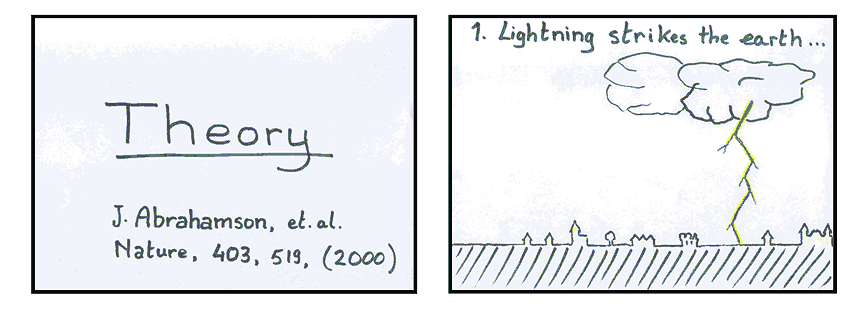
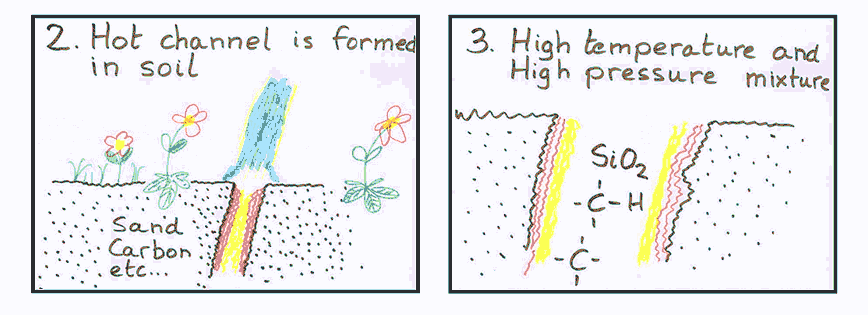
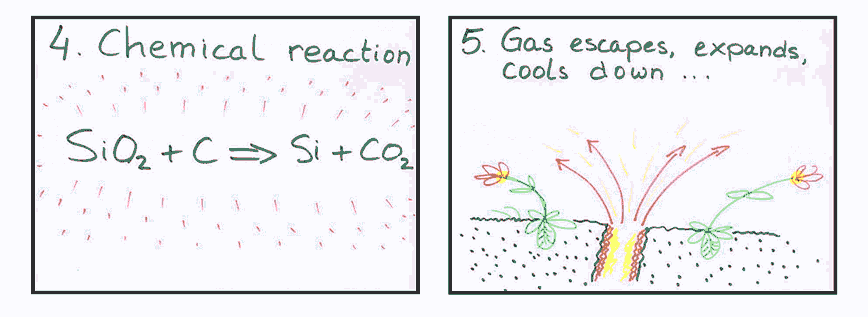
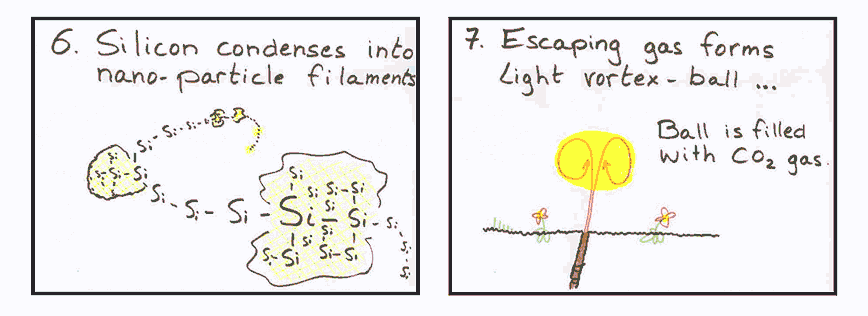
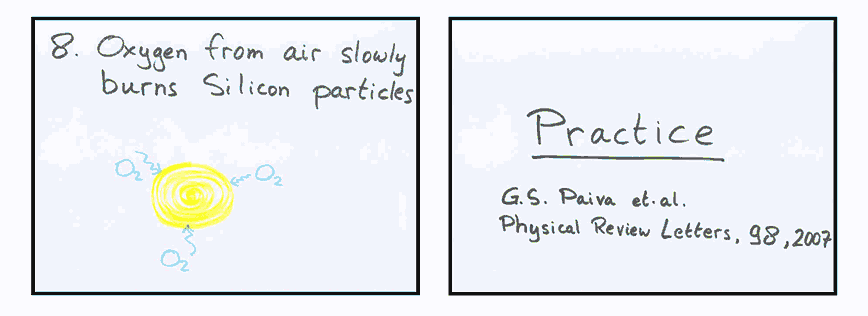
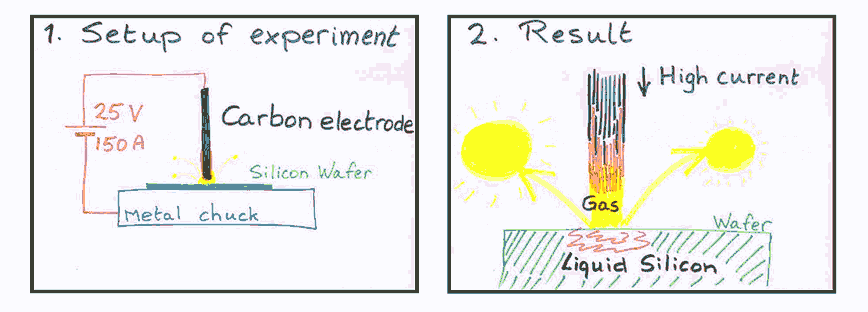
Figure 1. Cartoon by Martijn illustrating the theory on Ball Lightning by Abrahamson and Dinniss.
To reduce the resistance to the minimum, we used a heavily arsenic doped
<100> silicon wafer with a specific resistivity of 3-6 mohmcm.
The 6 inch silicon wafer was placed on a 2 cm thick Aluminium "chuck".
The chuck has 5 holes for bolts which are used for the connection
of the chuck to the negative poles of the power supplies using thick cables.

Figure 2. The Graphite electrode and the Aluminium chuck used in the experiment.
The silicon pieces are welded to the chuck.
A foiled sheet of copper was used to hold the graphite electrode. The graphite
electrode was a 3 mm diameter bar with a sharp tip. Aluminium foil was
used to tightly fit the carbon rod in the copper holder. Figure 2 depicts
both the chuck as well as the carbon anode. The silicon
parts are welded to the Aluminium plate.
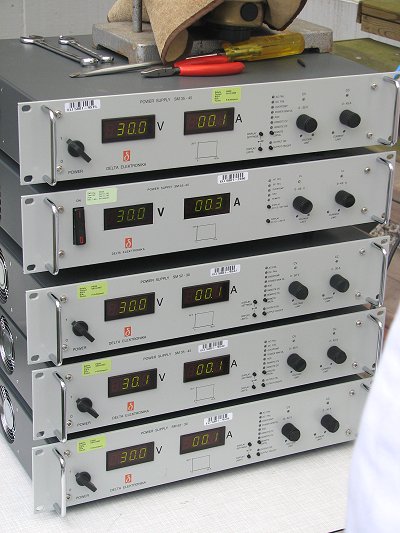
Figure 3. The power supplies in parallel used in the experiment
In contrast to the experiment by Paiva et al. we used a DC power supply. It consisted of five 50 V - 45 A power supplies in parallel (Fig. 3). The current drawn from the mains by these supplies was so large that we used three different mains groups to feed the power supplies. The power supplies made it possible to accurately set the voltage and the maximum current.
Because of safety reasons we where obliged to perform our experiments in
the open air. Apart from a heat resistant glove I wore a goggle with
a UV filter.
The best results were obtained at a voltage of about 20 V with the current compliance set at maximum. Higher voltages produced more sparks, which is spectacular, but less or even none spheres. Starting with a fresh silicon wafer on the chuck, the graphite tip is brought into contact with the wafer. Now obviously the silicon wafer somewhere has a best contact to the Aluminium chuck. The current will thus follow the lowest resistance path from the graphite tip to this best contact point. This will locally heat the wafer. Since silicon has a negative temperature coefficient, the resistance of this lowest resistance path will even further reduce. The result is that the current will be forced into a narrow path through the wafer, which can be observed as a bright illuminated line across the wafer. One would expect this to be a straight line, but that is not the case. Like a real lightning stroke, this line follows an irregular pattern.
The heat produced by the current running through the "lowest resistance
path" immediately causes crystal deformations, and after a fraction of a
second causes the wafer the break along this path.
In one of the movies at the bottom of this page it can be seen how the
wafer breaks on thouching it with the carbon tip.
The fractions thus have
a highly irregular shape, which is strange since silicon normally breaks
allong the <111> planes. After a few seconds of "probing around" with the
graphite rod, the silicon wafer is reduced into a heap of small silicon
fragments. It is at this point that the ball lightning like spheres
start to appear.

Figure 4. The only sphere caught on a high-resolution photograph.
The spheres have the size of about 2-3 mm. On the movies and photographs they appear to be larger because they over-expose the sensor in the camera (Fig. 4). The spheres are quite different from normal sparks. The sparks emitted from the arc usually bounce one or perhaps two times, and then fade away. The spheres on the other hand live much longer, up to 6-8 seconds. They bounce around in various directions. As can be seen in the video, the height of the bounces varies. Careful examination of the video in slow motion reveals that some bounces are much higher than the previous bounce. The energy needed for this increase in height might come from the heat in the sphere, from an exothermic reaction going on in the sphere, or from rotational energy, if indeed the sphere is rotating. After the sphere extinguishes sometimes a residue seems to remain.
Personnaly I am still not fully convinced that the spheres are not just
oddly behaving sparks. However, we showed the videos to some professional
welders, who spend their whole life amongst welding sparks. They assured
us that they had never seen sparks behaving in this way.
But then again, they are not welding silicon with carbon electrodes!
Also the bystanders
who witnessed the experiment were convinced that the spheres were quite
different in behaviour from regular sparks.